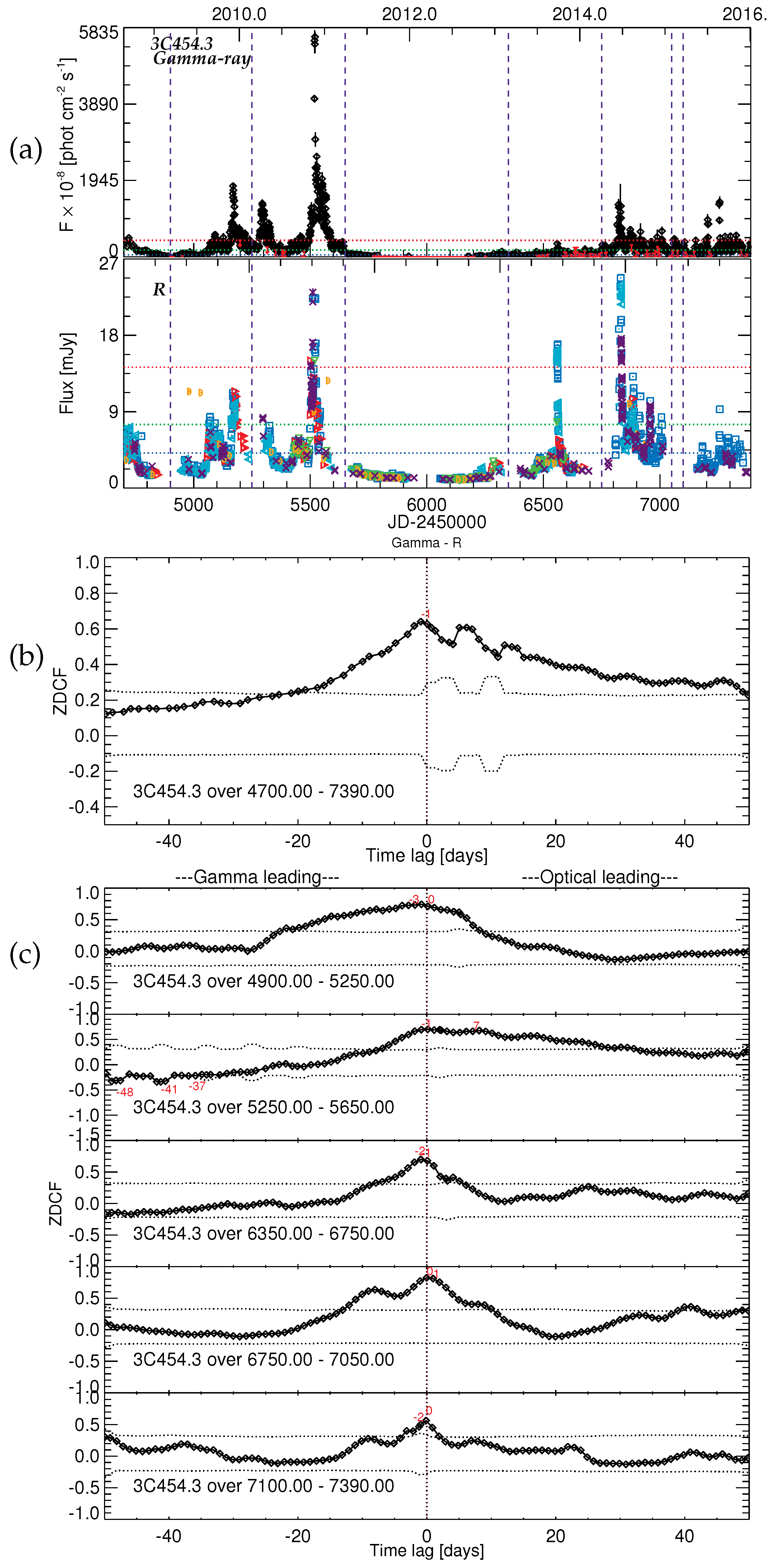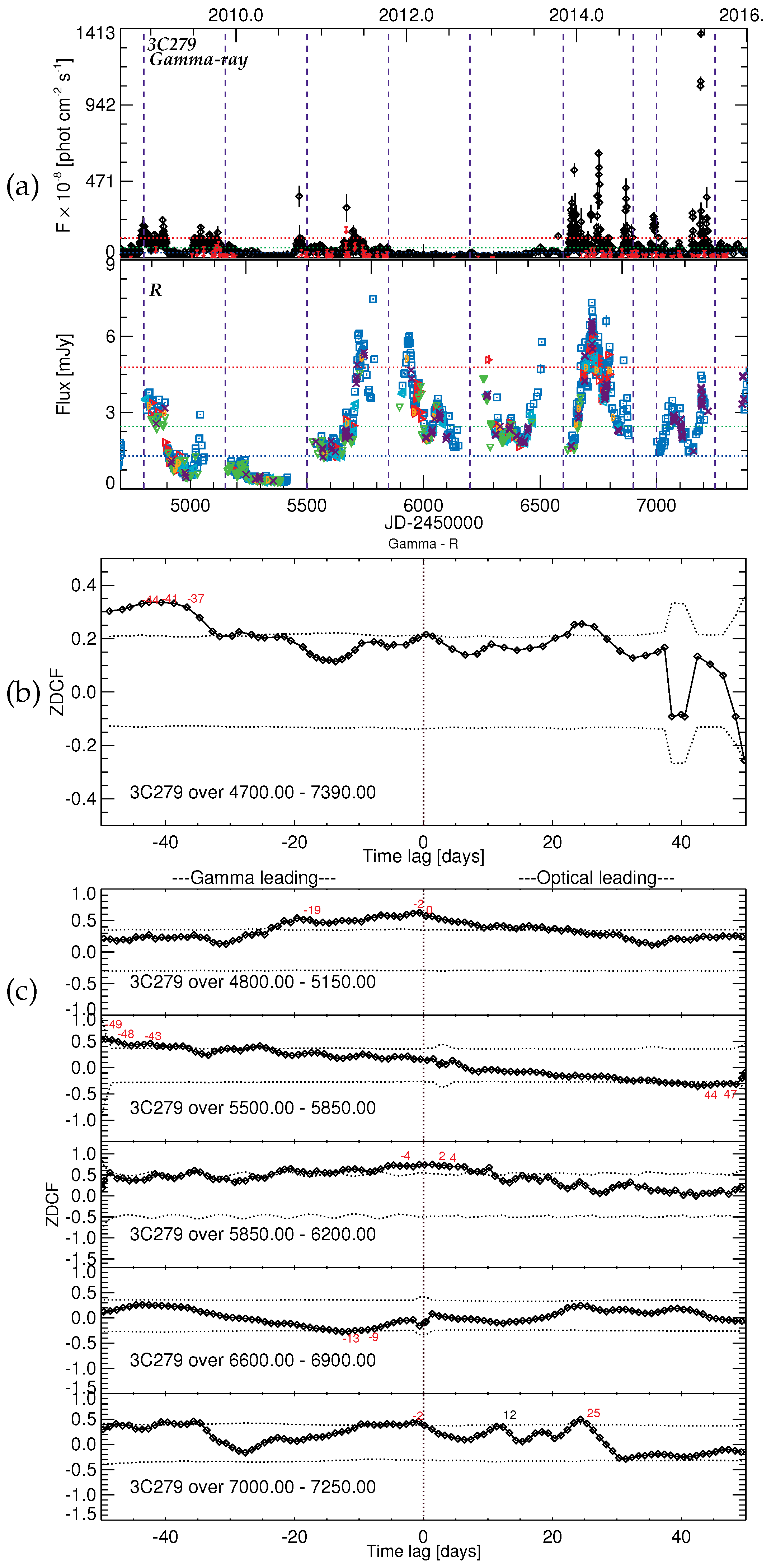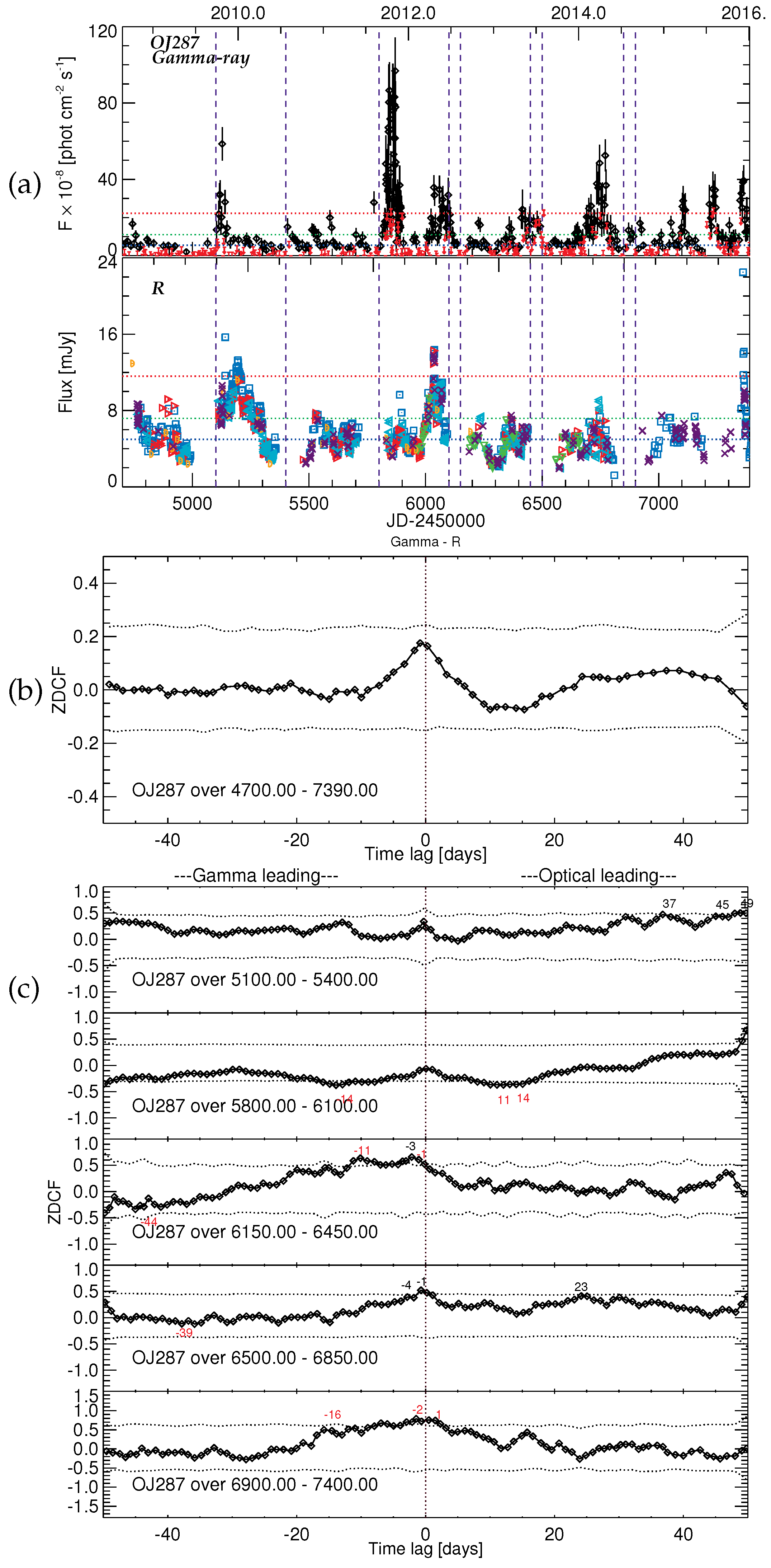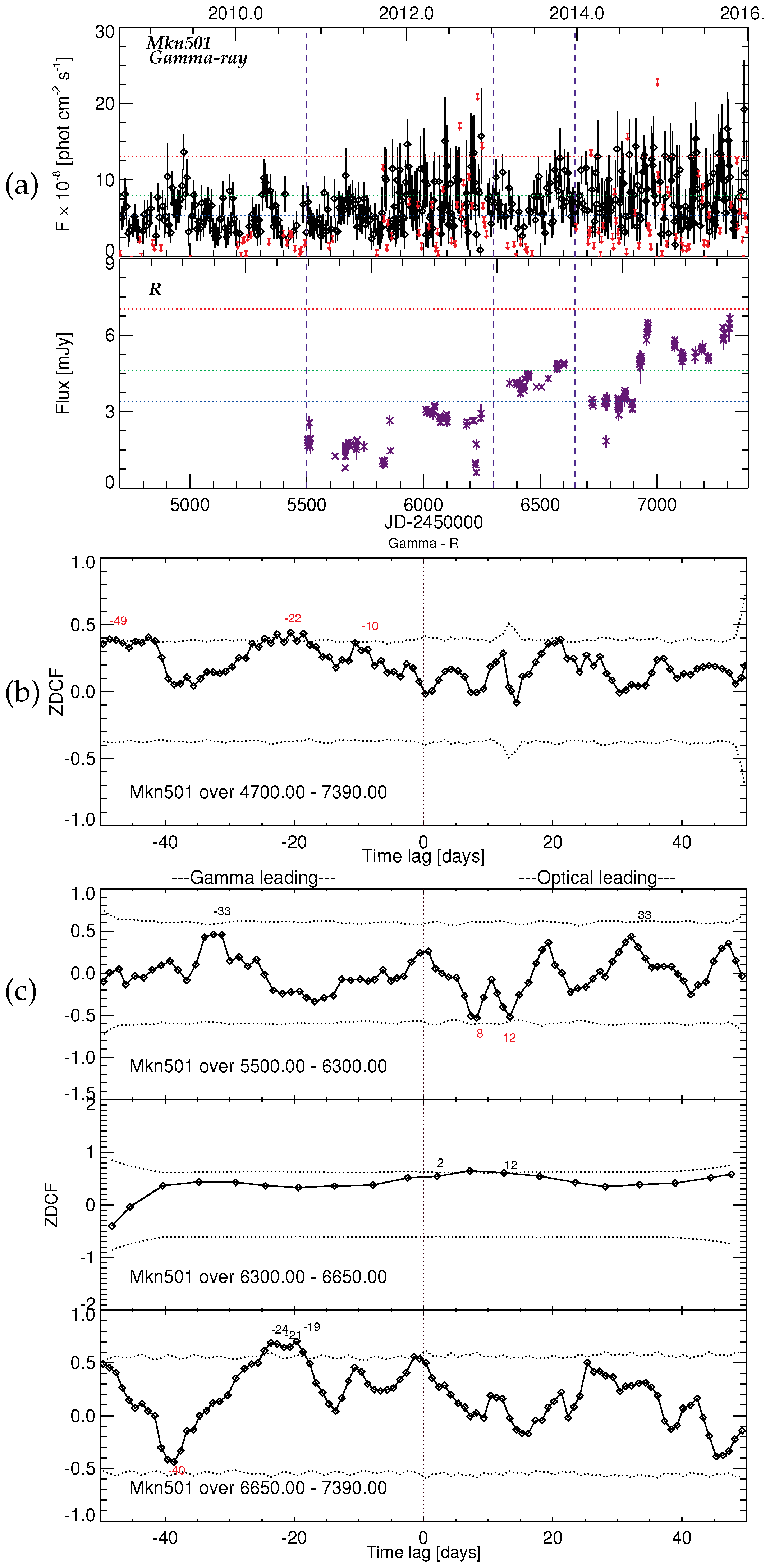Correlation Analysis of Delays between Variations of Gamma-Ray and Optical Light Curves of Blazars
Abstract
:1. Introduction
2. Results
3. Method
- Each object’s active periods are identified based on the light curve behavior (details can be found in [11]).
- Most -ray active periods with fluxes exceeding + 3 are re-reduced, allowing the photon index to vary and binning on a shorter time interval. Optical data are binned into 1-day periods.
- For each source, the ZDCF is calculated for the entire time span of observations and for each active period.
- Each ALC is built by randomly selecting and randomly placing active periods, preserving the observational dates by either using the closest observed point, if within 7 days, or interpolating the data.
- After the active periods have been placed in the ALC, the remaining observational fluxes are randomly selected and randomly placed on the remaining observational dates.
- The ALCs are randomly paired and sent through the ZDCF for analysis.
- Results of the ZDCF analysis of ALCs are used to derive 1-, 2-, and 3-σ probabilities to obtain a given coefficient of correlation by chance.
4. Summary
Acknowledgments
Author Contributions
Conflicts of Interest
Abbreviations
| MDPI | Multidisciplinary Digital Publishing Institute |
| DOAJ | Directory of open access journals |
| ZDCF | z-transformed discrete correlation function |
| ALC | artificial light curves |
| OC | Overall Correlation |
| CIC | Consistent Individual Correlation |
References
- Sikora, M.; Stawarz, Ł.; Moderski, R.; Nalewajko, K.; Madejski, G.M. Constraining Emission Models of Luminous Blazar Sources. Astrophys. J. 2009, 704, 38–50. [Google Scholar] [CrossRef]
- Ghisellini, G.; Tavecchio, F. Canonical high-power blazars. Mon. Not. R. Astron. Soc. 2009, 397, 985–1002. [Google Scholar] [CrossRef]
- Dermer, C.D.; Finke, J.D.; Krug, H.; Böttcher, M. Gamma-Ray Studies of Blazars: Synchro-Compton Analysis of Flat Spectrum Radio Quasars. Astrophys. J. 2009, 692, 32–46. [Google Scholar] [CrossRef]
- Nalewajko, K.; Begelman, M.C.; Sikora, M. Constraining the Location of Gamma-Ray Flares in Luminous Blazars. Astrophys. J. 2014, 789, 161. [Google Scholar] [CrossRef]
- Jorstad, S.G.; Marscher, A.P.; Larionov, V.M.; Agudo, I.; Smith, P.S.; Gurwell, M.; Lähteenmäki, A.; Tornikoski, M.; Markowitz, A.; Arkharov, A.A.; et al. Flaring Behavior of the Quasar 3C 454.3 Across the Electromagnetic Spectrum. Astrophys. J. 2010, 715, 362–384. [Google Scholar] [CrossRef]
- Larionov, V.M.; Jorstad, S.G.; Marscher, A.P.; Raiteri, C.M.; Villata, M.; Agudo, I.; Aller, M.F.; Arkharov, A.A.; Asfandiyarov, I.M.; Bach, U.; et al. Results of WEBT, VLBA and RXTE monitoring of 3C 279 during 2006–2007. Astron. Astrophys. 2008, 492, 389–400. [Google Scholar] [CrossRef]
- Agudo, I.; Molina, S.N.; Gómez, J.L.; Marscher, A.P.; Jorstad, S.G.; Heidt, J. Mapcat: Monitoring AGN with Polarimetry at the Calar Alto Telescopes. Int. J. Mod. Phys. Conf. Ser. 2012, 8, 299. [Google Scholar] [CrossRef]
- Sokolov, A.; Marscher, A.P.; McHardy, I.M. Synchrotron Self-Compton Model for Rapid Nonthermal Flares in Blazars with Frequency-dependent Time Lags. Astrophys. J. 2004, 613, 725–746. [Google Scholar] [CrossRef]
- Alexander, T. Is AGN Variability Correlated with Other AGN Properties? ZDCF Analysis of Small Samples of Sparse Light Curves. In Astronomical Time Series; Maoz, D., Sternberg, A., Leibowitz, E.M., Eds.; Springer: Dordrecht, The Netherlands, 1997; Volume 218, p. 163. [Google Scholar]
- Alexander, T. Improved AGN light curve analysis with the z-transformed discrete correlation function. 2013; arXiv:1302.1508. [Google Scholar]
- Williamson, K.E.; Jorstad, S.G.; Marscher, A.P.; Larionov, V.M.; Smith, P.S.; Agudo, I.; Arkharov, A.A.; Blinov, D.A.; Casadio, C.; Efimova, N.V.; et al. Comprehensive Monitoring of Gamma-Ray Bright Blazars. I. Statistical Study of Optical, X-Ray, and Gamma-Ray Spectral Slopes. Astrophys. J. 2014, 789, 135. [Google Scholar] [CrossRef]




| Symbol | Telescope | |||
|---|---|---|---|---|
| Shape | Color | Observatory (Telescope or Monitoring Program) and Location | Diameter | Wavebands |
| Space-based | ||||
| ⋄ | black | Fermi Gamma Ray Space Telescope (LAT) | -ray (0.1 GeV–200 GeV) | |
| Ground-based | ||||
| × | indigo | Lowell Observatory (Perkins Telescope), Flagstaff, Arizona | 1.83 m | B, V, R, I |
| ◃ | light blue | Crimean Astrophysical Observatory (AZT-8) | 0.70 m | B, V, R, I |
| ▿ | green | Observatorio del Roque de los Muchachos | 2.00 m | R |
| (Liverpool Telescope), La Palma, Spain | ||||
 | orange | Calar Alto Observatory (MAPCAT), Andalucía, Spain | 2.20 m | R |
| □ | blue | Cerro Tololo Inter-American Observatory (SMARTS), | 0.90–1.50 m | B, V, R, J, K |
| Cerro Tololo, Chile | ||||
| ▹ | red | St. Petersburg University (LX-200), St. Petersburg, Russia | 0.40 m | B, V, R, I |
| Consistent Individual Correlations: | Consistent Individual Correlations: | |||
|---|---|---|---|---|
| −−Yes −− | −−No −− | |||
| BL Lac | FSRQ | BL Lac | FSRQ | |
| Overall Correlation: Yes | 0716+714 (-1) | 1633+382 (0) | 0235+164 (-6) | 0336-019 (-10) |
| BL Lac (-1) | 1730-130 (2) | 0954+658 (-1) | 0420-014 (-12) | |
| CTA102 (0) | 1219+285 (-11) | 0827+243 (-22) | ||
| 3C454.3 (0) | 1749+096 (0) | 1222+216 (-23) | ||
| Mkn421 (-13) | 1622-297 (+1) | |||
| 3C279 (-43) | ||||
| Overall Correlation: No | OJ287 (-1) | 0735+178 | 0836+710 | |
| 0829+046 | 1156+295 | |||
| 1055+018 | 1308+326 | |||
| Mkn501 | 1510-089 | |||
| 3C66A | 3C273 | |||
| 3C345 | ||||
© 2016 by the authors; licensee MDPI, Basel, Switzerland. This article is an open access article distributed under the terms and conditions of the Creative Commons Attribution (CC-BY) license (http://creativecommons.org/licenses/by/4.0/).
Share and Cite
Williamson, K.E.; Jorstad, S.G.; Marscher, A.P.; Larionov, V.M.; Agudo, I.; Arkharov, A.A.; Blinov, D.A.; Casadio, C.; Gómez, J.L.; Hagen-Thorn, V.A.; et al. Correlation Analysis of Delays between Variations of Gamma-Ray and Optical Light Curves of Blazars. Galaxies 2016, 4, 64. https://doi.org/10.3390/galaxies4040064
Williamson KE, Jorstad SG, Marscher AP, Larionov VM, Agudo I, Arkharov AA, Blinov DA, Casadio C, Gómez JL, Hagen-Thorn VA, et al. Correlation Analysis of Delays between Variations of Gamma-Ray and Optical Light Curves of Blazars. Galaxies. 2016; 4(4):64. https://doi.org/10.3390/galaxies4040064
Chicago/Turabian StyleWilliamson, Karen E., Svetlana G. Jorstad, Alan P. Marscher, Valeri M. Larionov, Iván Agudo, Arkady A. Arkharov, Dmitry A. Blinov, Carolina Casadio, José L. Gómez, Vladimir A. Hagen-Thorn, and et al. 2016. "Correlation Analysis of Delays between Variations of Gamma-Ray and Optical Light Curves of Blazars" Galaxies 4, no. 4: 64. https://doi.org/10.3390/galaxies4040064







